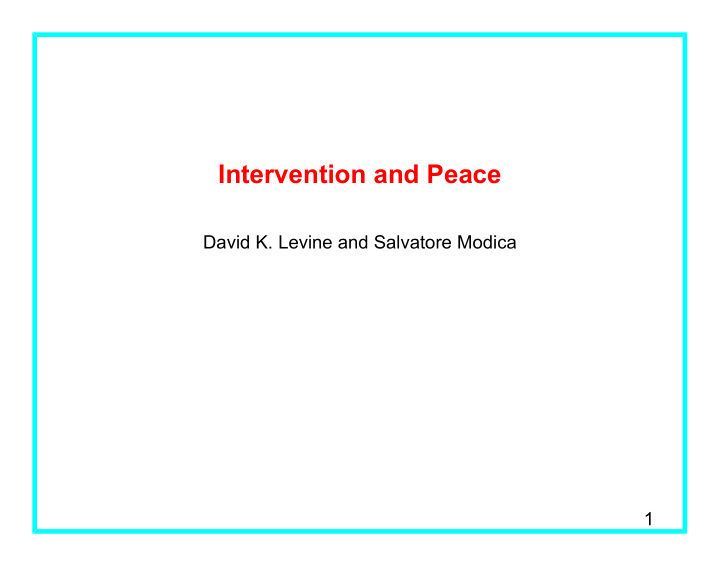



Intervention and Peace David K. Levine and Salvatore Modica 1
Intervention and Duration of Conflict • success in battle often increases control over resources and weakens the opponent making further victories easier • warfare is unstable – eventually one side gets lucky and wins • empirically this happens relatively rapidly: First and Second World Wars, U.S. Civil War – lasted about five years • by contrast with outside intervention warfare is often prolonged for decades: Vietnam War, Sudan, Angola, Lebanon 2
Simple Model of Bilateral Regional Conflict two groups denoted by controlling land and other resources in a particular region without significant geographical barriers conflict takes place over time resources of at time is ; units such that at most one unit can change hands in one period institutional strength or unit power of is makes it easier to prevail in conflict. aggregate power of is . more resources = more power probability that gains a unit of land from the conflict resolution function increasing in decreasing in 3
The Markov Process state variable the land holding of and with gives rise to a birth-death process as grows probability it continues to grow goes up capture the basic instability of warfare hegemony = one side has all the resources 4
Resistance chances of winning when heavily outnumbered very low where is resistance of to losing land to Assumption: resistance increases in own and decreases in opponent aggregate power. hegemonic resistance , assumed positive Assumption: weaker society has no resistance 5
Stochastic Stability and Hegemony unique ergodic probability distribution ; as unique limit ; places weight only on absorbing states for the process with those absorbing states that have positive probability in the limit distribution are called stochastically stable: observed “most of the time” when is small hegemonies of absorbing all the other states transient when : zero resistance to hegemony empirically hegemony is common • China, Egypt, Persia, Roman Empire, Caliphate, Ottoman Empire but not ubiquitous • Europe post Roman period, India • both appear to have involved substantial outside intervention 6
Intervention Thresholds outside power or powers intervention thresholds: if the outsiders reinforce with a fixed amount of power combined power of is 7
Weak Intervention and Hot Peace 1988-2001: Northern League in Afghanistan these conflicts are long but not particularly bloody 8
Medium Intervention and Prolonged War classical example: Vietnam long and bloody makes no sense from a humanitarian point of view good for keeping the combatants weak: classical British balance of power view of continental Europe one might argue that this is US policy in the Middle East 9
Strong Intervention and Hot Peace classical example: Cold War Europe staring eye-to-eye across a border again long but not especially bloody 10
Why Intervene? • prevent hegemony that may be threatening: Britain and the balance of power on the continent • extract economic rents: British Indian Empire? • sell arms: seems more alleged than real • extend military influence: Russia in Syria • domestic popularity: Cameron and Hollande in Libya • preserve trading partners: senseless – allow one side to win • moral considerations: evidence is weak that this occurs . 11
Single Intervenor no, weak or medium intervention • no intervention costless • weak intervention: expensive (your side is very weak) cost 1 • medium intervention: cost benefits • payoff to hegemony of either side is 0 • benefit of prolonged war • benefit of hot peace is (better to keep them fighting) Hence - with one player choosing both the row and column - that is whether to intervene on either or both sides - the payoff matrix to intervention is given by 12
Balance of Power Game medium weak none medium weak none 0 not intervene and get 0 intervene weakly on one side and get medium intervention on both sides and get weak intervention is too costly to be worthwhile is large and small so bloody conflict highly desirable and not much cost... 13
Two Intervenors 1.same cost structure 2.neither side has an advantage both get zero 3.each intervenor prefers their side to win for a favorable hot peace, for an unfavorable one for a favorable hegemony, for an unfavorable one assume also (would make the least cost intervention if your side got a hegemony) 14
The Great Game medium weak none medium weak none unique Nash equilibrium with medium intervention on both sides and a prolonged conflict 15
Prolonged War? historical instances of prolonged war brought about through outside intervention Vietnam, Angola, El Salvador: cold war conflicts – great game for sure Sudan, Lebanon, and Syria: Muslim regions no non-Muslim power cares whether Sunni's or Shia's gain a hegemony the cynical collusion theory has some force: many believe that a unified Muslim world in control of a substantial fraction of the world oil supply is a threat, so keep them fighting is worth something Western Europe perhaps miscalculated the cost not expecting refugees – except perhaps Germany which has taken advantage of them to rectify a long-standing demographic problem 16
Strong Versus Medium Intervention in the Great Game we treated them as the same makes a great deal of difference to the people living there strong requires both sides to acquiesce probably depends on whether both sides derive some advantage from peace • Europe: yes • Vietnam, Angola, El Salvador: no • Korea?? (entire country very poor at the time of the war) 17
Recommend
More recommend